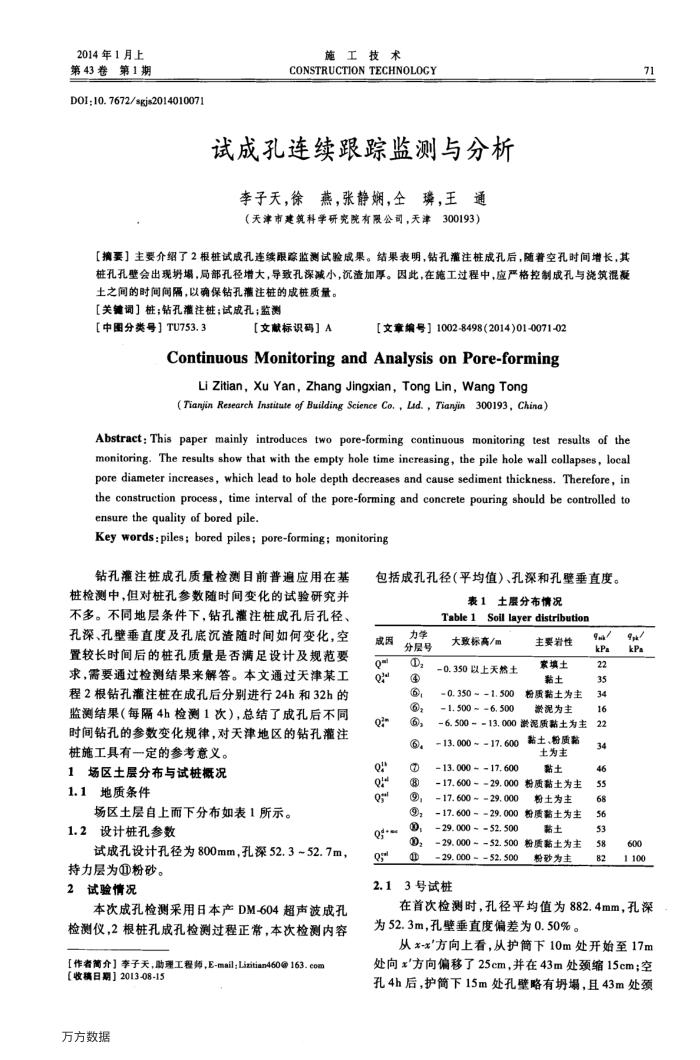您当前的位置:首页>论文资料>试成孔连续跟踪监测与分析
内容简介
 2014年1月上第43卷第1期
2014年1月上第43卷第1期DOI:10. 7672/sgjs2014010071
施工技术
CONSTRUCTION TECHNOLOGY
试成孔连续跟踪监测与分析李子天,徐燕,张静娴,全璞,王通(天津市建筑科学研究院有限公司,天津300193)
【摘要】主要介绍了2根桩试成孔连续跟踪监测试验成果。结果表明,钻孔灌注桩成孔后,随着空孔时间增长,其桩孔孔壁会出现塌,局部孔径增大,导致孔深减小,沉渣加厚。因此,在施工过程中,应严格控制成孔与瓷筑混凝
土之间的时间间隔,以确保钻孔灌注桩的成桩质量。【关键词】桩;钻孔灌注桩;试成孔;监测
[中图分类号】TU753.3
【文献标识码】A
[文章编号】1002-8498(2014)01-0071-02
ContinuousMonitoringand Analysis onPore-forming
Li Zitian,Xu Yan,Zhang Jingxian,Tong Lin,Wang Tong(Tianjin Research Institute of Building Science Co. , Lad. , Tianjin 300193, China)
Abstract:This paper mainly introduces two pore-forming continuous monitoring test results of the monitoring. The results show that with the empty hole time inereasing, the pile hole wall collapses, local pore diameter increases, which lead to hole depth decreases and cause sediment thickness. Therefore, in the construction process, time interval of the pore-forming and concrete pouring should be controlled to ensure the quality of bored pile.
Key words: piles; bored piles; pore-forming; monitoring
钻孔灌注桩成孔质量检测目前普遍应用在基桩检测中,但对桩孔参数随时间变化的试验研究并不多。不同地层条件下,钻孔灌注桩成孔后孔径、孔深、孔壁垂直度及孔底沉渣随时间如何变化,空置较长时间后的桩孔质量是否满足设计及规范要求,需要通过检测结果来解答。本文通过天津某工程2根钻孔灌注桩在成孔后分别进行24h和32h的监测结果(每隔4h检测1次),总结了成孔后不同时间钻孔的参数变化规律,对天津地区的钻孔灌注桩施工具有一定的参考意义。
1
场区土层分布与试桩概况
1.1
地质条件
场区土层自上而下分布如表1所示。 1.2
设计桩孔参数
试成孔设计孔径为800mm,孔深52.3~52.7m,持力层为粉砂。
试验情况 2
本次成孔检测采用日本产DM-604超声波成孔检测仪,2根桩孔成孔检测过程正常,本次检测内容【作者简介】李子天,助理工程师,E-mail;Lititian460163.com
【收稿日期】2013-08-15 万方数据
包括成孔孔径(平均值)、孔深和孔壁垂直度。
表1土层分布情况
Table 1Soil layer distribution
成因 Q Q
Q Q Q Q
力学分层号
????
??????
?
大致标高/m-0.350以上天然土 0. 350 ~ 1. 500 1. 500 ~ 6. 500
主要岩性家填土黏土粉质黏土为主
龄泥为主
6.500~-13.000激泥质粘土为主
13. 000 ~ 17. 600 13. 000 ~ 17. 600 17, 600 ~ 29, 000
土为主黏土
粉质黏土为主
17. 600 ~ 29, 000 17. 600 ~ 29, 000 29. 000 ~ 52. 500
粉土为主粉质黏土为主
黏土
29. 000 ~ 52. 500
粉质粘土为主
29.000
52.500
2.13号试桩
粉砂为主
Ya/ kPa 22 35 34 16 22 34 46 55 68 56 ES 58 82
71
9p kPa
600 1100
在首次检测时,孔径平均值为882.4mm,孔深为52.3m,孔壁垂直度偏差为0.50%。
从*-*方向上看,从护简下10m处开始至17m 处向x方向偏移了25cm,并在43m处颈缩15cm;空孔4h后,护简下15m处孔壁略有塌,且43m处颈
上一章:施工中污水净化系统的设计与实现
下一章:唐山勒泰中心大跨度屋面单层网壳施工方案优选